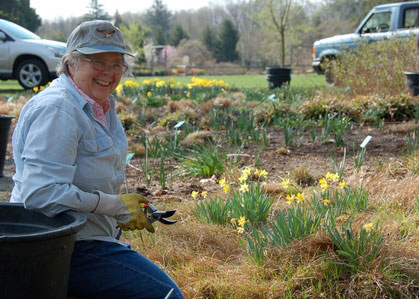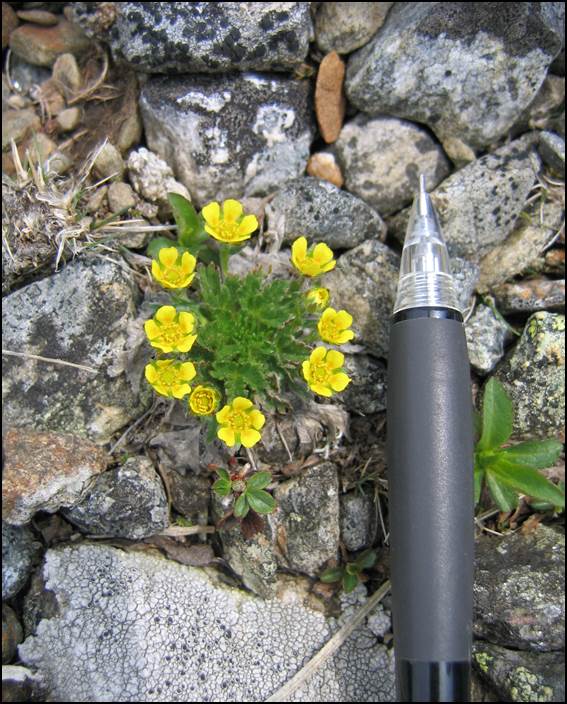Polly Pierce
Native plant enthusiast only begins to capture the essence of Polly Pierce. Undaunted by hurricanes or climate change, Polly is truly a conservation champion for native plants. In 2018, the Garden of Club of America awarded Polly the Natalie Peters Webster Medal “for sharing her love of native plants, showing us their beauty, encouraging their creative use, and ensuring their continued availability.” Polly was part of the circle of people instrumental in ensuring the early success of the Center for Plant Conservation and dedicated many years to serving on the CPC board. Today, Polly continues to support CPC with her generosity and wisdom.
When did you first fall in love with plants?
When I was a little kid. I guess it was the hurricane that got my attention – my first memory is of the hurricane in 1938. A tree crashed through my grandmother’s garage, and many oak trees had fallen at our home. The next day, I got to run around and explore the tops of the fallen trees, with the bird’s nests and everything in them. I still live in the same house I grew up in, and know the remaining pines and oaks very well.
My dad liked to garden, and my grandmother across the pond from us liked to have a garden. Her gardener was a jolly Irishman with four girls of his own – and he put me to work, no problem. I was 5, maybe 7. I’ve been surrounded by beautiful gardens all my life.
When I was married, I took a gardening class from Lucien “Kitty” Taylor (also a former New England Wild Flower Society president) through the Massachusetts Horticultural Society. Our last class was a field trip to the Garden in the Woods, and it was like going to heaven. I don’t know if it hooked others, but she certainly hooked me.
You have been involved with several conservation and gardening entities. What draws you to a nonprofit (as a member, donor, trustee, or any other capacity)?
I have always been, and continue to be, a very active person. I’ve been blessed enough to not have to work, and in my era women didn’t have the same opportunities and access to the same jobs. But I wanted to be involved, volunteer. Instead of sewing clothes or doing dinners as a volunteer, I turned to my interests. I loved plants. So gardening and conservation work made perfect sense.
The same goes for my donations and other types of volunteering. I wanted to fill a societal need – and CPC certainly needed resources! Though I still gave and still give to what others may call “normal” repositories for donations, such as hospitals and the like – – gardens, native plants, and education for these activities are my interests and what I give to more often.

In your experience, what are the benefits of gardening?
Joy. You get to see and experience what is there in the garden. I love learning about native plants, and through gardening I can see them up close. We all love the spectacle of a garden, but there is something special about a native wildflower garden – you see what belongs there, what the Lord put there. Gardening, especially native plant gardening, teaches you about where you are. You learn about the soil, light through changes in the year, temperature, and all that. You gain a sense of place.
Why do you believe it’s important to plant and protect native species?
They will vanish if we don’t. In horticulture, we may breed different varieties, but you have to keep the originals! We need to carry this over to nature as well. No extinction! Keep the originals.
Climate is changing. In living in one place my whole life, I see that climate has changed. Plant ranges are expanding northward – trillium did not occur in New England forests 50 years ago, and now it’s considered a native plant. The pond behind my house no longer freezes enough for me to ice skate. Summer birds can be seen here in winter. The threats are real and we need to do what we can.
What advice do you have for a gardener just dipping their toes into native plant gardening?
Attend to the soil! Study the plants and find out what soil they want, what exposure they want, and give it to them. NEWFS [now the Native Plant Trust] makes that easy for people. They provide resources, courses, and an outstanding garden showcasing native plants. It is very instructive to see what should be growing in your area in such a beautiful setting.
Can you share a story about your biggest challenge or most rewarding experience in working with and for native plants?
When CPC was being founded, I was president of NEWFS and was brought in because I knew Peter Ashton at Arnold Arboretum, who then introduced me to Peter Raven. I accompanied Peter Raven to talk to people at the Smithsonian about the budding idea for CPC to get their collaboration and support. Peter,who is a force and very persuasive, talked to them for half an hour solid or so, and they were on board. It was a new concept to me that people in authority, like those at the Smithsonian, really cared. That was very gratifying.
One little triumph was the work with Potentilla robbinsiana (Robbins’ cinquefoil). In supporting NEWFS, and Bill Brumback’s work, it was a true triumph in which Dan (my husband) and I had a hand. Bill was working with the seed from the one known population a mountain top and trying to get it to grow to help conserve it. Meanwhile, the one population was in the middle of the Appalachian Trail and threatened by trampling. We happened to know the president of the Appalachian Mountain Club and talked to him about moving the trail. Bill was able to germinate the seed at high altitudes, bring it down to nurseries and grow it very well. Eventually there was material for reintroductions. There are now four populations on different mountain tops and it was delisted from the endangered species list.
As an original CPC board member, what would you hope for the future of the organization?
Do what you’re doing. But better and more of it. Especially in the face of climate change, and the idea of what is native to where will be changing as the plants travel, we need to bring in more partners. Try to gather the Canadian and Mexican entities to do more for the plants of North America.
